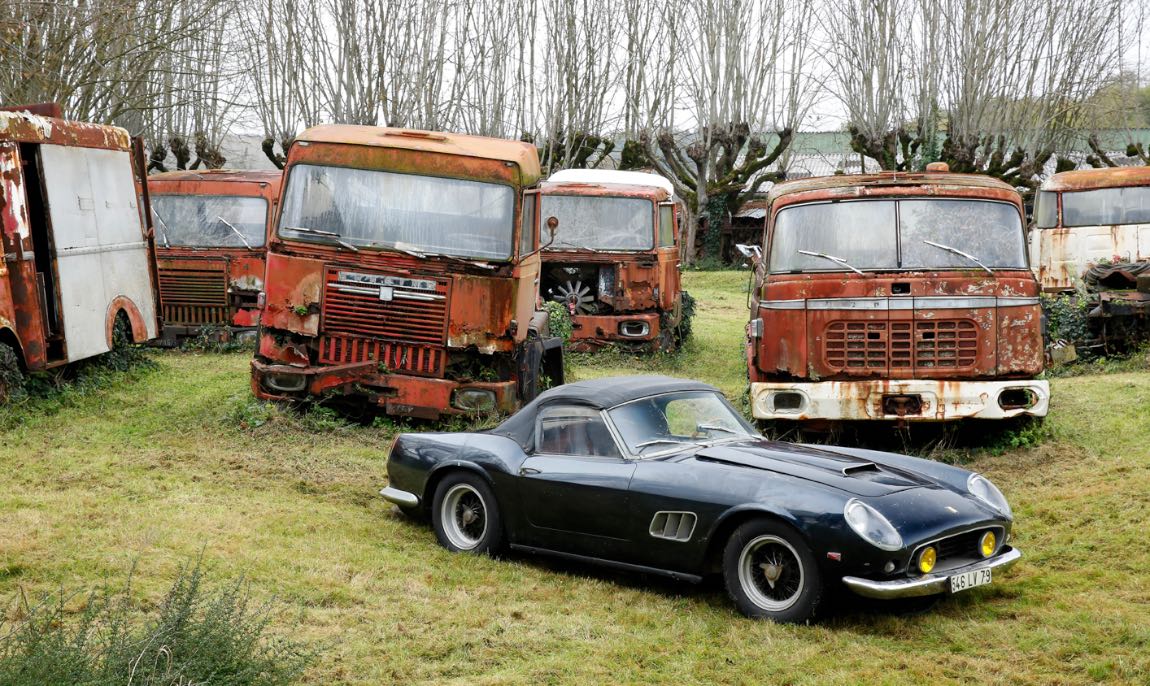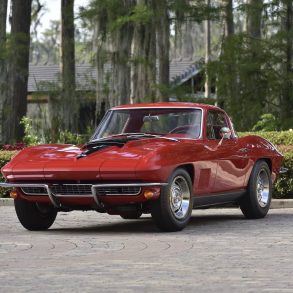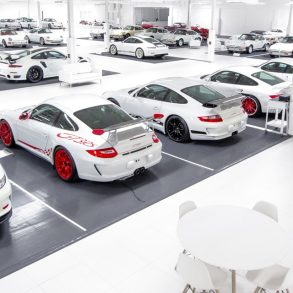It was in the West of France that the team from Artcurial’s collector car department made an extraordinary discovery. Forgotten for almost fifty years, the team at Artcurial found some 60 automobiles originally curated with devotion in order to create a private museum that would pay tribute to this great human invention. This unique collection will be offered for sale at the Artcurial Retromobile 2015 auction, scheduled for 6th February in Paris.
Matthieu Lamoure and Pierre Novikoff from Artcurial Motorcars share with Sports Car Digest about what it was like to find this incredible collection.
This has been like finding real treasure. Is it something that happens often to you?
Matthieu Lamoure, Managing Director of Artcurial Motorcars: This sort of thing doesn’t happen often enough! I think, above all, you go into this profession for discoveries like this. Yes, this really is a treasure. No doubt a once-in-a-lifetime discovery. In our jargon, we speak about “barn finds” as cars that are intact, that have remained untouched for years, and are found again. I have to say that when we arrived here, we found ourselves overcome with emotion. Probably much like Lord Carrington and Howard Carter, on being the first person for centuries to enter Tutankhamun’s tomb. It really was a case of waking up sleeping beauty.
Pierre Novikoff, Senior Specialist at Artcurial Motorcars: We are treasure hunters! I don’t think that the collectors’ car world has seen anything like this since the Schlumpf Collection, when Maitre Herve Poulain was the expert. This is surely the last time that such a discovery will be made, anywhere in the world. What is so special here is the number of cars (60), the range (from the early days of the motor car to the 1970s) and the quality and pedigree of the models. Unlike the Schlumpf collection that was known about and documented, ours is completely new. It’s a discovery!

This is becoming a speciality.
ML: I must say that at Artcurial Motorcars, we are committed to finding cars that have rarely or never been seen on the market before. This is our signature style, and is requires an incredible amount of work. We spend the year crossing Europe and travelling around the world. It is no coincidence that collectors come to our sales from across the globe year after year. This year, we realised close to 50 M€ / 66 M$ in sales, which is up 67% on 2013.
PN: The prices and the records are a welcome reward for our hard work. But to arrive in a small village in the West of France, and discover this treasure, is unheard of. We share the same passion as the collectors. They know our commitment and they stay with us. We share the same language. And it is this bond that enables us to coordinate auction sales like this one. I like to think it is our trademark!
How exactly did this start?
PN: It is quite a story. When we are preparing for a sale, we criss-cross France and travel around the world searching for rare pieces. A key part of our profession is being able to build relationships and to listen when we are told about something. On that particular day, I had a feeling that something was going to happen. On the phone, I gathered from the information I was given, that this could turn out to be something important. Without realising the scale. I spoke to Matthieu immediately and we arranged to go there, to find out what it was.



Finding Automotive Treasure – Interview Page Two
And when you arrived, what happened?
ML: It was a fairly indescribable feeling. On entering the gates of this property, we had no idea what we would find. We had to go in through the gardens at the rear of the property, to get a first look. Across three hectares, we could see different makeshift structures. Low shelters covered with corrugated iron. From there, we realised that this was something big. We still didn’t know what we were looking at, but could make out coachwork, weathered by time and the elements. Some modern shapes and others that were older.
PN: Incredible! The cars weren’t stored in solid, purpose-built sheds, but completely makeshift constructions. We came closer and realised that there were dozens of cars parked underneath. We soon realised that some of these had been put there 50 years earlier and left untouched. Wooden posts, between the cars, supported the fragile roofs. The sides were open to the elements. We still didn’t realise exactly what we were faced with — the number of cars, the marques, their condition.



It was practically an archeological excavation.
ML: Exactly! However, before the inventory, recording and researching their history, we needed to see everything. We continued our exploration at a second site, at the bottom of a field, then in one of the property’s outbuildings, an old barn that had been converted into an improvised garage.
PN: And there the shocks continued. The artistic and aesthetic shock first of all, faced with the beauty of these metallic sculptures. The emotional shock followed, as we came across incredible models and iconic marques. This was somewhere between a metallic graveyard and a museum. Nature had taken a hold, over the years. Ivy had invaded a car and entirely covered its wheel, while weeds had taken root in a passenger compartment as easily as in a greenhouse. In places, the sheets of corrugated iron were resting directly on the cars.
What is the story behind this treasure?
ML: Of course, this is the first question we asked ourselves! In front of such a collection, how could we not be curious, and want to find out? How had someone been able to amass so many cars? And for what purpose?
PN: Little by little, thanks to the owners, we learnt the story and the pieces of the puzzle began to fall into place. We were standing in front of the Baillon collection. Well documented, it had given rise to a large sale during the 1970s. It was thought that everything had been sold, and its existence had been forgotten about. And here, we had just found the lost collection! The troupe of red lorries, associated with the celebrated ‘Transports Baillon’ in the mid-20th century, left us in no doubt.



Finding Automotive Treasure – Interview Page Three
How did it come to be lost?
PN: I must tell you the story! It is essentially that of a great inventor and automobile enthusiast, although the collection was put together over several generations. Up until 1977, Roger Baillon had a transport and truck manufacturing business in the west of France. In 1947, this guy who was crazy about machines made a name for himself — he exhibited a car he had designed himself — the Oiseau bleu (blue bird). It was an ingenious vehicle, sculptural. It was the work of an artist, built to the highest standards.
ML: Roger Baillon made his fortune manufacturing trucks, at a time when the transport business was booming, after the war. He had the monopoly on transporters for dangerous liquid chemicals, thanks to the design of a secure, watertight tank. At the same time, he produced a revolutionary lorry in 1950 that featured the first ever ‘cabine avancee’ (forward-control cab) in the transport industry! It was moving to find the relics of this great era, in the garden of the property.
PN: It was between 1955 and 1965 that he amassed the largest part of the models. Unfortunately, during the 1970s, he suffered a reverse of fortune and his business went into decline. Which explains the large sale at the end of the decade.


But why collect the cars?
PN: This needs to be put into context. Although collectors’ cars, and particularly post-war French models, are snapped up today in the salerooms, this has not always been the case. At that time, Roger Baillon saved many of these cars from the scrapyard. With many significant models amongst them!
ML: This man was one of the early collectors. He wanted to celebrate the art of automotive engineering and bought a property to turn into an automobile museum. He began to buy key models in France and Europe. Having a transport business, it was straightforward for him to have his treasure delivered to the property he had bought in 1953 for this purpose. He even acquired a little train which he planned to use to make a tour of the museum, that would pass by all the cars.
PN: When the vehicles arrived, he put them away without much fuss, one next to the other. He restored some and left others as they were. He passed on his passion to his children and grandchildren. They continue to be very attached to this collection that they had watched expand, with the cars they had grown up around.



Finding Automotive Treasure – Interview Page Four
Did you go from one discovery to another when you started to make an inventory?
ML: 60 cars, legendary marques, in “barnfind” condition. It was already unbelievable! We had already spotted a few gems during our first tour of the machines, and making an inventory made us start to comprehend the extent of the collection. One mythical coachbuilder after another. I must tell you about three Talbots designed by Saoutchik : despite their condition, it was impossible not to fall in love with the lines of the Talbot Lago T26 Record Coupe by Saoutchik. It is like a work of art by Brancusi. When we contacted the marque historian to tell him we had found this car, he couldn’t believe it! Once he had recovered from the shock, he bombarded us with questions.
PN: I’m not sure I’ve ever seen so many exceptional cars together in one collection — Bugatti, Hispano-Suiza, Talbot- Lago, Panhard-Levassor, Maserati, Ferrari, Delahaye, Delage…Roger Baillon saved these cars and succeeded in his task — to trace the history of the automobile through the finest examples! When I look at the imposing Hispano Suiza H6B cabriolet Million-Guiet, a car built in France, I am impressed by the attention to detail and its proportions. These men were genuine artists.
You speak of them like genuine works of art.
PN: But that’s what they are! It is no coincidence that Artcurial has a collectors’ car department. Certain cars, much like paintings or sculptures, are works of art, created by artists ! Not only the engineering, but their styling reflects the history of design.
ML: I think you can feel the same emotion whether you are looking at the cubist forms of Pablo Picasso, the geometric but gentle shapes of Constantin Brancusi, a bookcase by the designer Ron Arad or the perfect styling of a Ferrari 250 GT SWB California Spider.




Is the Ferrari THE discovery?
ML: Ferrari is a legendary name in the automobile world. And this car is unique. Only 37 examples of this model were built making it extremely rare. Every example has been carefully documented by historians and this one was thought to be lost. We have found it!
PN: And we really did ‘find’ it — it was buried, in a garage, under a pile of papers (old copies of la Vie de l’Auto) and various covers. Not what you would expect for a car worth between €9.5 – €12 million. Its neighbour was another gem, a Maserati A6G Gran Sport Frua.

Finding Automotive Treasure – Interview Page Five
Do any of these cars have special history?
ML: The Ferrari, certainly! When we were making the inventory, we realised that the car used to belong to Alain Delon!
PN: It had been bought new by the actor Gérard Blain who sold it to his fellow actor Alain Delon. Delon was photographed several times at the wheel of this machine : in 1964 with Jane Fonda during the filming ‘Les Félins’ and on the Côte d’Azur with Shirley MacLaine.
ML: The collection also contains an extravagant Talbot Lago T26 cabriolet that once belonged to King Farouk.


What can you do with vehicles in this condition?
PN: All the cars are significant for their heritage, and we hope that some of them will join big collections in and outside France. Perhaps even museums. Amongst the 60 cars, the estimates vary from €500 to several million euros. They will be displayed and sold as they are. Just as we found them. Possibly one or two spider’s webs may be lost in transit, and some of the dust blown away, but that’s all!
ML: What is incredible is the condition of these cars. I think some should be left as they are, and others should be restored. This is a unique testimony. It is the collectors who have this opportunity to make the successful bid who will decide. If you think about it, there are always restored cars available to buy on the market. These vehicles are unique. This is a very rare opportunity presenting works of art unknown to the market! For the Talbot Lago T26 Grand Sport Coupe Saoutchik, caved in at the rear, I think it should be left in this condition. It is a sculpture.


The cars will be on display during the Salon Retromobile in February 2015. How do you transport such fragile objects?
ML: It is a highly technical and precise job, the same as transporting a work of art. We need to take as much care as if we were moving the Mona Lisa. The cars are loaded manually into special lorries, to be taken to a warehouse. There, like celebrities, they will be individually photographed in a studio, inspected and written up for the sale catalogue.
PN: You will see them again in February at the Parc des Expositions de la Porte de Versailles, in the major exhibition that precedes the sale on 6 February, at the Retromobile Salon.
For additional information, visit Artcurial Motorcars.

[Source: Artcurial Motorcars]











I don’t understand how these cars could have gone undiscovered for such a long time. They weren’t left in a locked, boarded up garage, everything was wide open for anyone to see.
Amazing!
Matt,
I think Matthieu and Pierre hinted at the reason when they mentioned that the Collection Baillon had been dispersed at auction decades ago to satisfy creditors. No one had any reason to think there might be others, so no one looked.
Furthermore they were located on family property well away from prying eyes. In France you don’t go poking around behind someone’s chateau on a lark.
Finally, I wouldn’t be surprised to learn that the dispersal of this collection coincides with the expiration of a statute of limitations on the debts that led to the public dispersal years ago and puts the proceeds out of reach of any creditors.
In any event it is pretty wonderful, even if many of the cars are in sad, neglected condition. I hope I can make it to Retromobile to see it.
Couldn’t the Chateau owners afford a thousand dollars worth of plywood and nails to enclose the bloody garages. Terrible shame that these cars were left to rot like they did.
“We found ourselves overcome with emotion”…no doubt
I was not aware greed was an emotion.
Is that a Mk 3 Ford Cortina I see ?
The first sale alluded to took place near Niort on june 23 and 24, 1979, with 58 cars sold at no reserve.
There is a full report in “Le Fanatique de l’Automobile” N° 130 dated July 1979. There were no really great cars then, apart from another 5 Talbots, and the report finishes with “The second sale, of which the date is not yet known, will surely be even more interesting”.
So this should be the second sale then …. 35 years after the first one!
Great information. Many thanks for sharing.
I visited this collection in September 1981 when I was touring France following attendance at the Vincenzo Lancia Centenary Rally in Torino.The cars were accessible and in much the same condition as shown now, although there were indeed fewer cars and some of the exotic Delahaye were not visual. I will try to find the photos I took at that time.
There have been people trying to buy the Ferrari in the past but with no result.
The owners probably told the auctioneers that the could do an auction if they remove all the cars from the property and not just one. Not a real forgotten treassure in my mind but still some nice cars.
I think it’s a manipulation of the public opinion to present this story as a barn find. Whoever the owner is, cannot be stupid enough not to estimate the value of these cars or at least try to find out all these years.
This leaves us with “expiration of a statute of limitations on the debts” as the only plausable reason for them suddenly being discovered -again-.
Interesting that all the snarky comments come from “anonymous”.
I am truly amazed that this collection exists and aghast at the people that have kept its secrets. My only hope is that the automotive historians will find worthy patrons to bring most of these pieces of art and craftsmanship back to there glory so that future generations of of our hobby can enjoy these pieces of an era automotive art.
“We need to take as much care as if we were moving the Mona Lisa.”
Oh please.
“For the Talbot Lago T26 Grand Sport Coupe Saoutchik, caved in at the rear, I think it should be left in this condition. It is a sculpture.”
Yes. A ruined sculpture. “Should be left in this condition.” ? Why. Because it is so bad off that it’s not worth restoring?
I don’t care that the “snarky comments” come from “anonymous”.
Incredible history!!!!
Very interesting story.